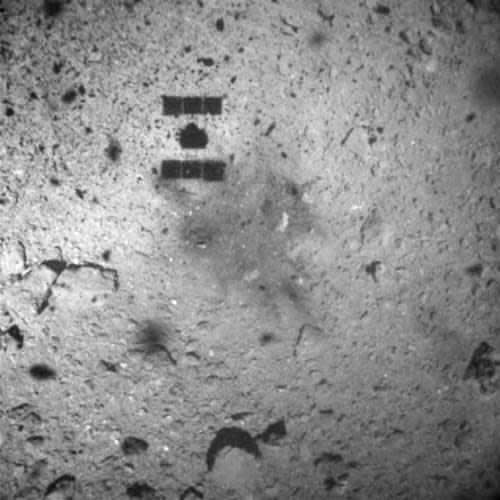Japan’s Hayabusa 2 successfully touches down on Ryugu asteroid

A Japanese spacecraft has successfully touched down on a speeding asteroid 300 million kilometres from the Earth as it attempts an audacious manoeuvre to collect samples and bring them back for scientists to study.
The Hayabusa 2 probe touched down on the asteroid Ryugu at around 11:30pm GMT on Thursday. Data from the probe showed changes in speed and direction, indicating it had reached the asteroid’s surface, according to officials from the Japan Aerospace Exploration Agency (JAXA).
A live webcast of the control room showed dozens of JAXA staff members nervously monitoring data ahead of the touchdown before exploding into applause after receiving a signal from Hayabusa2 that it had landed.
“We made a successful touchdown, including firing a bullet” into the Ryugu asteroid, Yuichi Tsuda, Hayabusa 2 project manager, told reporters.
“We made the ideal touchdown in the best conditions,” he said.
JAXA spokeswoman Chisato Ikuta said the control centre had “received data that shows that the probe is working normally and is healthy.”
Scientists are continuing to gather and analyse data from the probe, she said.
The probe was due to fire a bullet at the Ryugu asteroid, to stir up surface matter, which it will then collect for analysis back on Earth. The asteroid is thought to contain relatively large amounts of organic matter and water from some 4.6 billion years ago when the solar system was born.
The complicated procedure took less time than expected and appeared to go without a hitch, said Hayabusa 2 mission manager Makoto Yoshikawa.
“I’m really relieved now. It felt very long until the moment the touchdown happened,” he said.
He said the firing of the bullet - the first of three planned in this mission - “will lead to a leap, or new discoveries, in planetary science.”
The spacecraft is seeking to gather 10g of the dislodged debris with an instrument named the Sampler Horn that hangs from its underbelly.
Whatever material is collected by the spacecraft will be stored onboard until Hayabusa 2 reaches its landing site in Woomera, South Australia, in 2020 after a journey of more than three billion miles.
The Japanese Aerospace Exploration Agency published live updates of the landing on Thursday night, and spirits were high.
In footage broadcast from the control room, presenters repeatedly described the smiles on the faces of team members. When Doppler data came through showing “behaviour as expected” after the spacecraft landed, the official Twitter account for the mission reported “cheers went up with a clap!”
But there was no rest for the team, with the Hayabusa 2 account tweeting: “A group photograph was taken in the control room. Now everyone is back to work again.”
Hayabusa 2 caught up with Ryugu in June last year after a three-and-a-half-year journey to intercept it. Mission controllers at the Japanese space agency had planned to touch down in October, but delayed the attempt after cameras revealed the surface to be far rockier than expected.
The asteroid belongs to a family of space rocks that are the most primitive building blocks of the solar system. “This is the material that didn’t get swept up into planets, it got left behind,” said John Bridges, a professor of planetary science at the University of Leicester. “The reason we want to study it is that this is what material was like at year zero.”
Similar material falls to Earth as meteorites, but it is battered and burned as it tears through the atmosphere and quickly becomes contaminated when it thumps into the ground. The asteroid material from Hayabusa 2 will show scientists what meteorite material is like before it plunges to Earth.

 Yahoo News
Yahoo News 